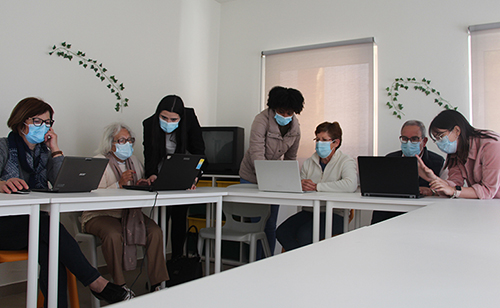What was the main purpose of Aging Laboratory?
“The purpose of the project is to increase knowledge of aging, in cooperation with researchers, artists, students, technicians, volunteers, and seniors. In today’s societies, development has been associated with scientific research, the ability to create new knowledge and innovative outputs”, says Mariana Ramos from Municipality of Ílhavo.
Currently, the Laboratory of Aging and the University of Porto (UPorto) are developing the pilot phase of the local strategy of digital and integrated gerontological intervention of Municipality of Ílhavo. The Municipality of Ílhavo and its partners intend to develop a “Community of Digital Integrated Care” for its older citizens. This community will act as an integrated care ecosystem that uses interoperable technologies such as Voice Assistant, Smartwatch, Smartphone, Apps and, Fall Sensors. These technologies connect older people, their informal caregivers (family, friends, neighbourhood), health care providers and social support staff (Health Centre, Continuing Care) and its gerontological intervention program (Maioridade)”.
We also collaborate with a research team of the Center for Research and Cognitive- Behavioural Intervention (CINEICC) of the University of Coimbra, in a research project UpMind, aimed at optimising cognitive functioning, emotional state and functionality.

Laboratory of Aging protects and qualifies projects and researchers through technical and strategic support. The knowledge axis of the project collaborates with partners, technicians and students, who bring us their knowledge in an innovative way. Meetings and workshops are held to share experiences.
The creation axis of the Laboratory hosts creative projects, developed by the hands of seniors and artists. It is an inter-generational link between classical knowledge and emerging sectors. The main objective of the installation of the Laboratory of Aging is, ultimately, to change the way older people are represented in society. It is necessary to demystify the idea that all elderly people are sick and incompetent. This ideological change involves a more in-depth investigation of the manifestations of ageism in our society.
We intend to expand the possibilities of these projects by including women who have been confined mainly to the domestic sphere and management of family life. Starting from an inter-generational perspective, it is possible to combat stereotypes, including ageism, as well as enable the exchange of knowledge between generations”.
How did the project foster transformative learning and values?
“The Laboratory of Aging promotes lifelong learning, valuing traditional knowledge and intergenerational sharing. We are focused on age discrimination, which is made increasingly visible by demographic change. This discrimination, called ageism, is based on beliefs, prejudices and behaviours about aging, particularly in relation to older ages.
Aware that ageism exists, it is necessary that the State and civil society promote an image more adjusted to the reality of the elderly. It is urgent to think of the fundamental contribution that older people can make to increase economic growth, both from a productive and consumer point of view. The intervention developed within the project aims to combat the prejudices associated with ageism and promote transformative values among all generations”.

What was the best practice learnt from this project that you want to share?
“The Laboratory of aging, through its most diverse dynamics and events, has been promoting the physical and mental health of those enrolled. Through social screenings the project combats social problems, such as loneliness, which essentially affect the older people.
We have developed various learning sessions and cultural enrichment, for instance learning sessions of computer content, creative sewing sessions, embroidery; gardening and horticulture; visits to television shows; participation in theaters, choirs, and short films, among others. The social impact is wide, since it allows combating prejudices associated with old age, such as ageism and “standard activities for the older”, but also problems such as loneliness, exclusion and stigmatisation or pejorative social representations of older people.
As initially mentioned, the practice implemented around the study of the impacts of our dynamics is a continuous process that allows us to change and adapt our events and activities according to the circumstances”.
Text: Dimitra Kladia, EAEA
Photos: Aging Laboratory

